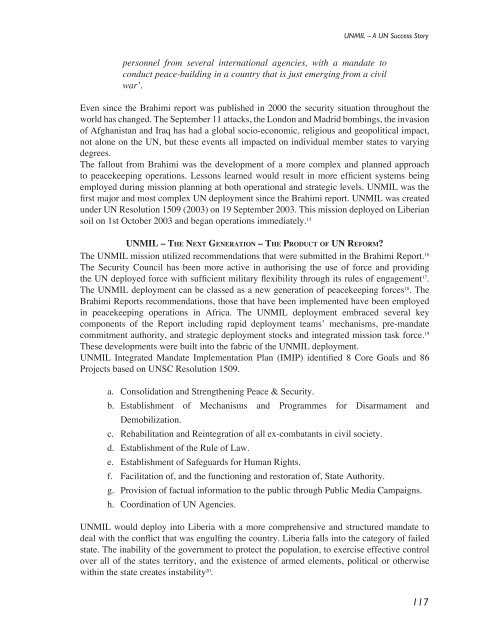Defence Forces Review 2008
Defence Forces Review 2008
Defence Forces Review 2008
Create successful ePaper yourself
Turn your PDF publications into a flip-book with our unique Google optimized e-Paper software.
UNMIL – A UN Success Story<br />
personnel from several international agencies, with a mandate to<br />
conduct peace-building in a country that is just emerging from a civil<br />
war’.<br />
Even since the Brahimi report was published in 2000 the security situation throughout the<br />
world has changed. The September 11 attacks, the London and Madrid bombings, the invasion<br />
of Afghanistan and Iraq has had a global socio-economic, religious and geopolitical impact,<br />
not alone on the UN, but these events all impacted on individual member states to varying<br />
degrees.<br />
The fallout from Brahimi was the development of a more complex and planned approach<br />
to peacekeeping operations. Lessons learned would result in more efficient systems being<br />
employed during mission planning at both operational and strategic levels. UNMIL was the<br />
first major and most complex UN deployment since the Brahimi report. UNMIL was created<br />
under UN Resolution 1509 (2003) on 19 September 2003. This mission deployed on Liberian<br />
soil on 1st October 2003 and began operations immediately. 15<br />
UNMIL – Th e Ne x t Ge n e r a t i o n – Th e Pr o d u c t o f UN Re f o r m<br />
The UNMIL mission utilized recommendations that were submitted in the Brahimi Report. 16<br />
The Security Council has been more active in authorising the use of force and providing<br />
the UN deployed force with sufficient military flexibility through its rules of engagement 17 .<br />
The UNMIL deployment can be classed as a new generation of peacekeeping forces 18 . The<br />
Brahimi Reports recommendations, those that have been implemented have been employed<br />
in peacekeeping operations in Africa. The UNMIL deployment embraced several key<br />
components of the Report including rapid deployment teams’ mechanisms, pre-mandate<br />
commitment authority, and strategic deployment stocks and integrated mission task force. 19<br />
These developments were built into the fabric of the UNMIL deployment.<br />
UNMIL Integrated Mandate Implementation Plan (IMIP) identified 8 Core Goals and 86<br />
Projects based on UNSC Resolution 1509.<br />
a. Consolidation and Strengthening Peace & Security.<br />
b. Establishment of Mechanisms and Programmes for Disarmament and<br />
Demobilization.<br />
c. Rehabilitation and Reintegration of all ex-combatants in civil society.<br />
d. Establishment of the Rule of Law.<br />
e. Establishment of Safeguards for Human Rights.<br />
f. Facilitation of, and the functioning and restoration of, State Authority.<br />
g. Provision of factual information to the public through Public Media Campaigns.<br />
h. Coordination of UN Agencies.<br />
UNMIL would deploy into Liberia with a more comprehensive and structured mandate to<br />
deal with the conflict that was engulfing the country. Liberia falls into the category of failed<br />
state. The inability of the government to protect the population, to exercise effective control<br />
over all of the states territory, and the existence of armed elements, political or otherwise<br />
within the state creates instability 20 .<br />
117
















